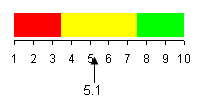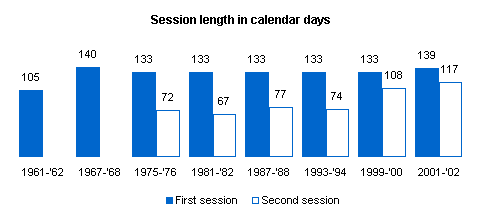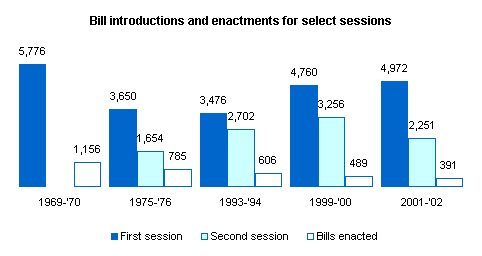
|
Reforming Politics as Usual Increased cynicism toward government and elected officials is, in part, a product of Minnesota's complicated two-house system of government where a few powerful legislators call the shots. An unprecedented amount of unregulated money is being spent to influence our elections. Folks are tired of "politics as usual." The Ventura administration is pursuing several initiatives to reform the structure of the legislature, our legislative process, and the campaign finance system. We want to build a government that is more accountable, responsive and limited, and to restore citizens' trust in government and our elected officials.
The Big Accounting Initiative Score Goal: Level the playing field between incumbents and challengers. Percentage of House candidates' campaign expenditures paid with public subsidy. Goal: Limit special interest money in campaigns. Goal: A simpler, more accountable and more accessible political process. Length of the legislative session (in calendar days). Number of bills introduced each legislative session, and number of bills that actually become law. |
|||||||||||||||||||||

|
|||||||||||||||||||||
Percentage of House candidates' campaign expenditures paid with public subsidy. |
|||||||||||||||||||||
|
|
|
||||||||||||||||||||
Note: This indicator is meant to track how Minnesota's public subsidy program is keeping up with the cost of campaigns. Minnesota House of Representatives campaign expenditures have been tracked as a more consistent, every-other-year proxy for all campaign spending. In Minnesota, we have a unique campaign finance system that provides public funds to candidates who agree to low contribution and spending limits. Since 1998, 98 percent of registered candidates have participated in the public subsidy program and voluntarily limited their contributions and spending. Minnesota's low-cost campaigns have helped to level the playing field between challengers and incumbents and have given more third party and independent candidates the ability to run competitive campaigns. The administration's goal is to continue Minnesota's tradition of low-cost, competitive campaigns by increasing the percentage of campaign expenditures paid for with public subsidy. |
|||||||||||||||||||||
| top
|
|||||||||||||||||||||
|
|
|
||||||||||||||||||||
Note: Independent expenditures are monies spent to advocate the election or defeat of a candidate, but made without the consent, authorization or cooperation of that candidate. Typically these expenditures fund negative ads attacking a candidate, but not using the magic words "vote for" or "vote against." The opposing candidate(s) has no accountability for the content of the ad, and does not have to report the expenditure as part of his or her spending. House caucuses are political organizations dedicated to electing and supporting House members of a particular party. In 1999, a federal court judge struck down Minnesota's law limiting independent expenditures made by political party units. Since that time, we have seen an explosion in the amount of money that parties, particularly legislative party caucuses, are pouring into these unregulated independent expenditures in key legislative races. In some legislative districts, the caucuses outspend the candidates themselves five or six to one. The administration recognizes the importance of free speech in political campaigns; however, we are concerned about the ability of candidates to respond to attacks that often occur in the final days of the election. Our goal is to give candidates the tools that they need to respond by prohibiting political parties and caucuses from making independent expenditures as a condition of accepting public money. |
|||||||||||||||||||||
| top
|
|||||||||||||||||||||
|
|
|
||||||||||||||||||||
Note: Independent expenditures are monies spent to advocate the election or defeat of a candidate, but made without the consent, authorization or cooperation of that candidate. Typically these expenditures fund negative ads attacking a candidate, but not using the magic words "vote for" or "vote against." The opposing candidate(s) has no accountability for the content of the ad, and does not have to report the expenditure as part of his or her spending. Political party units include local and national political parties and legislative party caucuses. Political committee is an association whose major purpose is to influence the nomination or election of a candidate or to promote or defeat a ballot question, other than a principal campaign committee or a political party unit. Political fund is an accumulation of dues or voluntary contributions by an association other than a political committee, principal campaign committee or party unit, if the accumulation is collected or expended to influence the nomination or election of a candidate or to promote or defeat a ballot question. Outside interest groups include political committees, political funds and issue advocacy groups. About three-quarters of independent expenditures in the 2000 elections were made by the four legislative caucuses (approximately $3 million). Most of these expenditures paid for negative campaign ads in the final days of the election and were targeted in a handful of key legislative races. In some cases, political parties and caucuses spent five or six times more than candidates are allowed to spend. Some critics of campaign finance reform argue that requiring political parties and caucuses to limit their independent expenditures as a condition of receiving public money will cause the money to move elsewhere in the system (that is, money will flow to outside interest groups who will make more independent expenditures). As we discuss and implement changes to our campaign finance system, it is important to track the movement of money in the system to determine whether we our meeting our goals. |
|||||||||||||||||||||
| top
|
|||||||||||||||||||||
|
|
|||||||||||||||||||||
Note: The Minnesota Legislature has met in session every year since the passage of a 1972 constitutional amendment allowing "flexible sessions." This change was intended to allow for more thoughtful consideration of major policy and budget issues, avoid end-of-session logjams, and allow brief consideration of unfinished business from the previous year. These goals have not been realized. In fact, since we went to flexible sessions, we've seen more bills introduced, more laws passed, longer sessions, more legislative logjams and more permanent growth in state spending. Until 1973 "legislative days" were measured consecutively and the clock began ticking the moment the legislature convened (excluding Sundays). Following the passage of the 1972 amendment allowing flexible sessions, lawmakers defined a legislative day as a day when either the House or Senate met in full session. This definition of "legislative day" left the 120-day constitutional maximum untouched, but allowed lawmakers to spread the days over a two-year period. Although the Minnesota Legislature is constitutionally limited to meeting 120 legislative days per biennium, the number of calendar days that the legislature spends in session has increased. The administration is interested in legislative reforms that will inject more accountability into the process, and ultimately, reduce the amount of time the legislature spends in session. |
|||||||||||||||||||||
| top
|
|||||||||||||||||||||
Number of bills introduced each legislative session, and number of bills that actually become law. |
|||||||||||||||||||||
|
|
|||||||||||||||||||||
Note: The change to flexible sessions was intended to avoid end-of-session logjams and allow brief consideration of unfinished business from the previous year, however, this has not been the case. Instead, we have seen an increase in the number of bills introduced each biennium and a greater number of bills offered and passed in the second year of the biennium. The administration's legislative reform proposals allow for more thoughtful consideration of major policy and budget issues, increase accountability for decision-making, and provide more opportunities for public input. These reforms would curtail activity in the second year of the biennium by focusing legislators on emergency items that might need legislative consideration. |
|||||||||||||||||||||
| top
|
|||||||||||||||||||||





